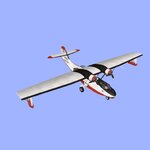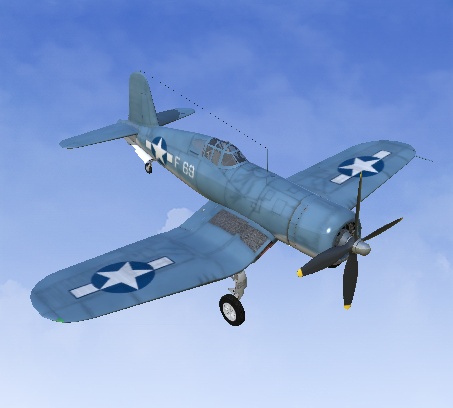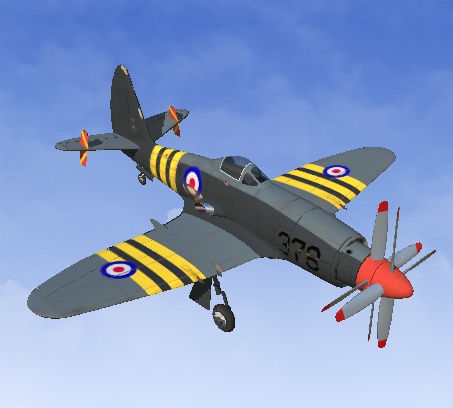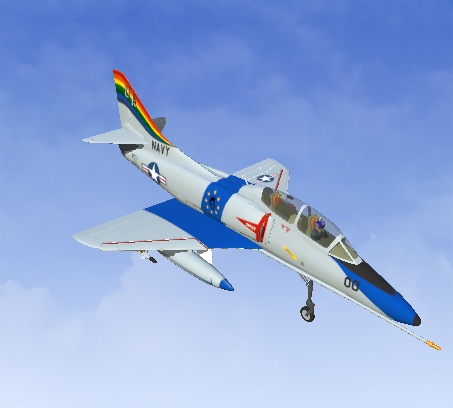A larger Catalina. Very majestic and may require some control co-ordination in turns. Based on the excellent EA!
Catalina facts: The PBY Catalina was an American flying boat of the 1930s and 1940s. It could be equipped with depth charges, bombs, torpedoes, and .50 Browning machineguns and was one of the most widely used multi-role aircraft of World War II. PBYs served with every branch of the US military and in the air forces and navies of many other nations. In the United States Army Air Forces and later in the USAF their designation was the OA-10, while Canadian-built PBYs were known as Cansos.
In World War II, PBYs were used as anti-submarine warfare aircraft, patrol bombers, convoy escorts, search and rescue aircraft, and transports. The PBY was the most successful aircraft of its kind, as no other flying boat was produced in greater numbers. The last active military PBYs were not retired from service until the 1980s. Even today, over seventy years after its first flight, the aircraft continues to fly as an airtanker in aerial firefighting operations all over the world. The PBY was originally designed to be a patrol bomber, an aircraft with a long operational range intended to locate and attack enemy transport ships at sea in order to compromise enemy supply lines. With a mind to a potential conflict in the Pacific Ocean, where troops would require resupply over great distances, the U.S. Navy in the 1930s invested millions of dollars in developing long-range flying boats for this purpose. Flying boats had the advantage of not requiring runways to take off and land, in effect having the entire ocean available as its runway. Several different flying boats were adopted by the Navy, but the PBY was the most widely used and produced.
PBY riding at sea anchor.
PBY riding at sea anchor.
Although slow and ungainly, PBYs distinguished themselves in World War II as exceptionally reliable. Allied armed forces used them successfully in a wide variety of roles that the aircraft was never intended for. They are remembered by many veterans of the war for their role in rescuing downed airmen, in which they saved the lives of thousands of aircrew shot down over the Pacific Ocean.
Specifications (PBY-5A)
Data from Encyclopedia of World Air Power,[12] Jane's Fighting Aircraft of World War II,[3] and Quest for Performance[13]
General characteristics
* Crew: 8 — pilot, co-pilot, bow turret gunner, flight mechanic, radioman, navigator and two waist gunners
* Length: 63 ft 10 in (19.46 m)
* Wingspan: 104 ft 0 in (31.70 m)
* Height: 20 ft 2 in (6.15 m)
* Wing area: 1,400 ft² (130 m²)
* Empty weight: 20,910 lb (9,485 kg)
* Max takeoff weight: 35,420 lb (16,066 kg)
* Powerplant: 2× Pratt & Whitney R-1830-92 Twin Wasp radial engines, 1,200 hp (895 kW each) each
* Zero-lift drag coefficient: 0.0309
* Drag area: 43.26 ft² (4.02 m²)
* Aspect ratio: 7.73
Performance
* Maximum speed: 196 mph (314 km/h)
* Cruise speed: 125 mph (201 km/h)
* Range: 2,520 mi (4,030 km)
* Service ceiling 15,800 ft (4,000 m)
* Rate of climb: 1,000 ft/min (5.1 m/s)
* Wing loading: 25.3 lb/ft² (123.6 kg/m²)
* Power/mass: 0.034 hp/lb (0.056 kW/kg)
* Lift-to-drag ratio: 11.9
Armament
* 3× .30 cal (7.62 mm) machine guns (two in nose turret, one in ventral hatch at tail)
* 2× .50 cal (12.7 mm) machine guns (one in each waist blister)
* 4,000 lb (1,814 kg) of bombs or depth charges, torpedo racks were also available
Catalina facts: The PBY Catalina was an American flying boat of the 1930s and 1940s. It could be equipped with depth charges, bombs, torpedoes, and .50 Browning machineguns and was one of the most widely used multi-role aircraft of World War II. PBYs served with every branch of the US military and in the air forces and navies of many other nations. In the United States Army Air Forces and later in the USAF their designation was the OA-10, while Canadian-built PBYs were known as Cansos.
In World War II, PBYs were used as anti-submarine warfare aircraft, patrol bombers, convoy escorts, search and rescue aircraft, and transports. The PBY was the most successful aircraft of its kind, as no other flying boat was produced in greater numbers. The last active military PBYs were not retired from service until the 1980s. Even today, over seventy years after its first flight, the aircraft continues to fly as an airtanker in aerial firefighting operations all over the world. The PBY was originally designed to be a patrol bomber, an aircraft with a long operational range intended to locate and attack enemy transport ships at sea in order to compromise enemy supply lines. With a mind to a potential conflict in the Pacific Ocean, where troops would require resupply over great distances, the U.S. Navy in the 1930s invested millions of dollars in developing long-range flying boats for this purpose. Flying boats had the advantage of not requiring runways to take off and land, in effect having the entire ocean available as its runway. Several different flying boats were adopted by the Navy, but the PBY was the most widely used and produced.
PBY riding at sea anchor.
PBY riding at sea anchor.
Although slow and ungainly, PBYs distinguished themselves in World War II as exceptionally reliable. Allied armed forces used them successfully in a wide variety of roles that the aircraft was never intended for. They are remembered by many veterans of the war for their role in rescuing downed airmen, in which they saved the lives of thousands of aircrew shot down over the Pacific Ocean.
Specifications (PBY-5A)
Data from Encyclopedia of World Air Power,[12] Jane's Fighting Aircraft of World War II,[3] and Quest for Performance[13]
General characteristics
* Crew: 8 — pilot, co-pilot, bow turret gunner, flight mechanic, radioman, navigator and two waist gunners
* Length: 63 ft 10 in (19.46 m)
* Wingspan: 104 ft 0 in (31.70 m)
* Height: 20 ft 2 in (6.15 m)
* Wing area: 1,400 ft² (130 m²)
* Empty weight: 20,910 lb (9,485 kg)
* Max takeoff weight: 35,420 lb (16,066 kg)
* Powerplant: 2× Pratt & Whitney R-1830-92 Twin Wasp radial engines, 1,200 hp (895 kW each) each
* Zero-lift drag coefficient: 0.0309
* Drag area: 43.26 ft² (4.02 m²)
* Aspect ratio: 7.73
Performance
* Maximum speed: 196 mph (314 km/h)
* Cruise speed: 125 mph (201 km/h)
* Range: 2,520 mi (4,030 km)
* Service ceiling 15,800 ft (4,000 m)
* Rate of climb: 1,000 ft/min (5.1 m/s)
* Wing loading: 25.3 lb/ft² (123.6 kg/m²)
* Power/mass: 0.034 hp/lb (0.056 kW/kg)
* Lift-to-drag ratio: 11.9
Armament
* 3× .30 cal (7.62 mm) machine guns (two in nose turret, one in ventral hatch at tail)
* 2× .50 cal (12.7 mm) machine guns (one in each waist blister)
* 4,000 lb (1,814 kg) of bombs or depth charges, torpedo racks were also available






